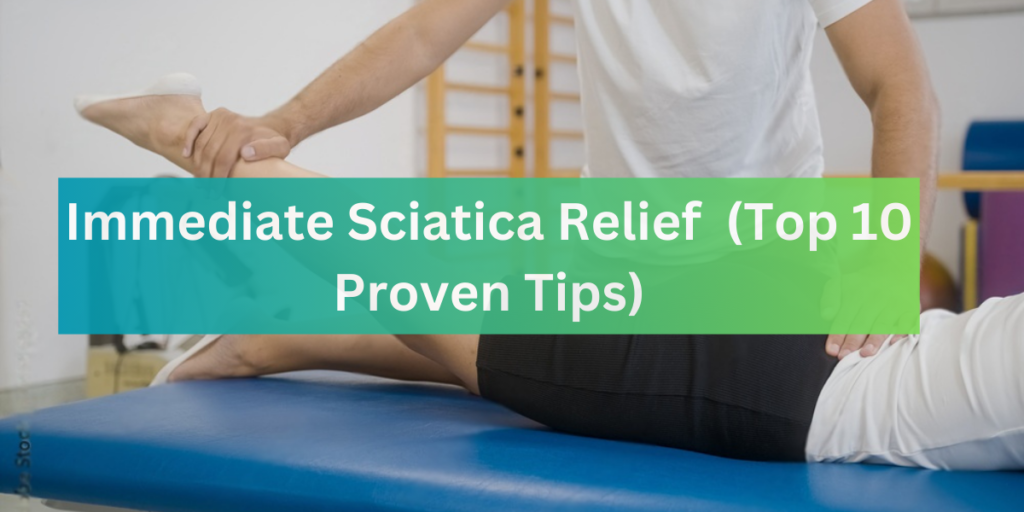
Immediate Sciatica Relief (Top 10 Proven Tips)
Sciatica is a common condition that causes pain, numbness, and weakness in the legs and lower back. This article will provide you with a comprehensive guide on how to find immediate sciatica relief.
We’ll cover the best stretches for instant relief, at-home remedies, prevention tips, specific exercises to help prevent sciatica, and how a chiropractor can offer immediate relief.
By the end of this article, you’ll have a better understanding of sciatica and the tools to manage your pain effectively.
What is Sciatica and What Causes the Pain?
Sciatica refers to pain that radiates along the path of the sciatic nerve, which runs from the lower back through the hips and buttocks and down each leg. Sciatica is often caused by a herniated disc, bone spur, or spinal stenosis compressing part of the nerve.
What are the Best Stretches for Immediate Sciatica Relief?
When sciatica pain rears its ugly head, you need relief, and you need it fast. That’s where stretching comes in. Stretching can help alleviate pressure on the sciatic nerve and reduce pain.
Here are some of the best stretches to try when you’re in the throes of a sciatica flare-up:
1. Seated glute stretch

Sit on a chair and cross your affected leg over the opposite knee. Gently lean forward until you feel a stretch in your buttock. Hold for 30 seconds, then repeat on the other side.
2. Figure 4 stretch

Lie on your back with your knees bent. Cross your affected leg over the opposite thigh, creating a “4” shape. Reach behind your unaffected leg and pull it toward your chest until you feel a stretch in your buttock. Hold for 30 seconds, then repeat on the other side.
3. Knee to opposite shoulder stretch

Lie on your back with your legs extended. Bend your affected leg and bring your knee toward the opposite shoulder. Use your hands to gently pull your knee closer to your shoulder until you feel a stretch. Hold for 30 seconds, then repeat on the other side.
4. Standing hamstring stretch

Place your affected leg on a slightly elevated surface, like a step or a low stool. Keeping your back straight, lean forward until you feel a stretch in the back of your thigh. Hold for 30 seconds, then repeat on the other side.
5. Prone press-ups

Lie on your stomach with your hands under your shoulders. Slowly push your upper body off the ground, keeping your hips on the floor. Hold for 5-10 seconds, then lower back down. Repeat 10 times.
Stretching should never be painful. If you experience pain during any of these stretches, stop immediately and consult with a healthcare professional.
At-Home Remedies for Fast Sciatica Pain Relief
When you’re dealing with sciatica pain, you want relief, and you want it now. Luckily, there are several at-home remedies you can try to help ease your discomfort:
1. Hot and cold therapy
Applying heat or cold to the affected area can help reduce pain and inflammation. Try using a heating pad or taking a warm bath to relax tense muscles. If you’re experiencing swelling, opt for an ice pack instead.
2. Over-the-counter pain medications
Nonsteroidal anti-inflammatory drugs (NSAIDs) like ibuprofen and naproxen can help reduce pain and inflammation. Acetaminophen can also be effective for pain relief.
3. Keep moving
While it may be tempting to stay in bed when you’re in pain, prolonged rest can actually make sciatica worse. Try to maintain gentle movement throughout the day, even if it’s just a short walk around the block.
4. Proper posture
Pay attention to your posture when sitting, standing, and sleeping. Use a supportive chair and avoid slouching. When sleeping, try placing a pillow between your knees to keep your spine aligned.
5. Gentle exercise
Low-impact exercises like swimming, cycling, and yoga can help strengthen your core and improve flexibility, which may help reduce sciatica pain.
If your pain persists or worsens despite trying these at-home remedies, it’s important to consult with a healthcare professional.
How Can You Prevent Sciatica Flare-ups?
Sciatica flare-ups can be a real pain in the butt (pun intended). But there are steps you can take to help prevent them from happening in the first place:
- Maintain good posture: Mom was right – stand up straight! Good posture can help reduce pressure on your sciatic nerve and prevent pain.
- Exercise regularly: Staying active is key to preventing sciatica flare-ups. Focus on exercises that strengthen your core and improve flexibility, like yoga and Pilates.
- Lift properly: When lifting heavy objects, be sure to use proper form. Bend at your knees, not your waist, and keep the object close to your body.
- Set up an ergonomic workspace: If you spend a lot of time sitting at a desk, make sure your workspace is set up ergonomically. Use a chair with good lumbar support and keep your computer screen at eye level.
- Maintain a healthy weight: Excess weight can put added pressure on your spine and increase your risk of sciatica. Aim to maintain a healthy weight through a balanced diet and regular exercise.
- Stretch regularly: Incorporating stretching into your daily routine can help keep your muscles flexible and reduce your risk of sciatica flare-ups.
By making these lifestyle changes, you can help keep sciatica pain at bay and enjoy a more comfortable, active life.
Are There Specific Exercises That Can Help Prevent Sciatica?
Yes, certain exercises can help strengthen your core, improve flexibility, and prevent sciatica. Some of these exercises include:
- Scissor hamstring stretch
- Back flexion stretch
- Single knee-to-chest stretch
- Seated hamstring stretch
- Piriformis stretch
- Double knee-to-chest
- Lower trunk rotations
- Pelvic tilt
How Can a Chiropractor Offer Immediate Relief for Sciatica?
As a top chiropractor in Melbourne, I offer immediate sciatica treatment. I use spinal manipulation techniques to relieve pressure on the sciatic nerve and trigger point therapy to relax tense muscles.
Additionally, I provide personalized stretching and exercise recommendations to help my patients manage their sciatica pain.
Chiropractic care can be highly beneficial for those suffering from sciatica, offering fast relief and long-term pain management strategies.
When to Seek Professional Treatment for Sciatica?
If you experience persistent or worsening pain despite home remedies, severe pain, or progressive weakness, it’s essential to seek professional treatment. Treatment options from healthcare providers may include:
- Prescription medications (muscle relaxants, steroids)
- Physical therapy
- Steroid injections
- Surgery (in severe cases)
Sciatica pain can be debilitating, but there are many ways to find immediate relief and prevent future flare-ups. By incorporating stretches, at-home remedies, preventive measures, and specific exercises into your routine, you can effectively manage your sciatica pain.
If your pain persists or worsens, don’t hesitate to seek professional help from a chiropractor or other healthcare provider.

Flynn Pettersson
I am committed to providing exceptional chiropractic care in Melbourne, focused on your health and well-being.

Flynn Pettersson
I am committed to providing exceptional chiropractic care in Melbourne, focused on your health and well-being.






